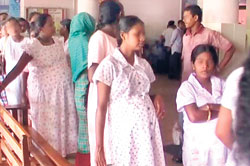Sneezing, sniffling and coughing, the flu seems everywhere. As the second wave of A/H1N1 virus takes on the pattern of a seasonal flu, health officials while urging the public not to panic stressed that vulnerable groups should be extra-cautious.
Explaining that the World Health Organization (WHO) has now declared that H1N1 is in the ‘post-pandemic period’ or last phase, the Family Health Bureau, however, advised expectant mothers to take care as pregnancy is a recognized co-morbidity for this virus.
The Maternal and Child Morbidity and Mortality Surveillance Unit of the bureau is making all efforts to prevent maternal deaths due to H1N1, said Consultant Community Physician Dr. Kapila Jayaratne.
H1N1 if contracted during pregnancy is considered “a high risk condition”, he says adding that there could be complications especially in pregnant women with co-morbidities such as diabetes, heart disease and bronchial asthma.
It is also associated with an increased risk of adverse pregnancy outcomes including spontaneous abortion, preterm birth and foetal distress, according to him.
It is important not only for pregnant women but also those in the reproductive age group to be aware of the symptoms of this virus infection, MediScene understands. They are fever along with a cough, sore throat, rhinorrhoea, headache, muscle pain and malaise.
Advising pregnant women to avoid unnecessary travel, crowded public places and public transport as much as possible, Dr. Jayaratne says that pregnant women and new mothers should avoid providing care for persons with influenza-like illnesses except for their own newborns.Any pregnant mother with acute febrile respiratory illness (fever > 38oC) with symptoms ranging from cough, sore throat, shortness of breath to pneumonia, should consult a qualified physician (either in the government or private sector).
These mothers should be admitted to a hospital if they present with features of complicated influenza or progressive disease manifestations of cardio-respiratory distress (e.g. shortness of breath either during physical activity or while resting dyspnoea, tachypnea, hypoxia, low blood pressure); radiological signs of lower respiratory tract disease (e.g. pneumonia); central nervous system involvement (e.g. altered mental status, unconsciousness, drowsiness, recurring or persistent convulsions (seizures), confusion, severe weakness or paralysis); severe dehydration; persistent high fever and other symptoms beyond 3 days.
Most pregnant women can be managed if Oseltamivir is started early. It is a must to start Oseltamivir when H1N1 is suspected without waiting for laboratory confirmation, he said, adding that Chemoprohylaxis is NOT recommended in pregnancy. The patient should also be provided the necessary supportive therapy (adequate nutrition and oral fluids) and medication (antipyretics, antibiotics where indicated, rehydration etc). Non-Steroidal Anti Inflammatory Drugs (NSAIDs) should be avoided. |


